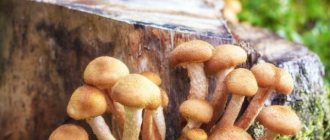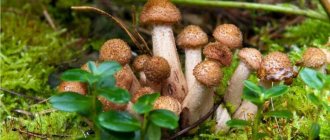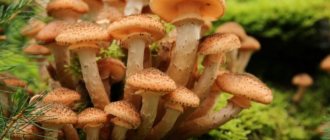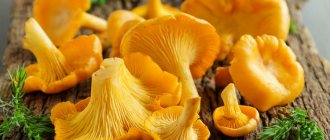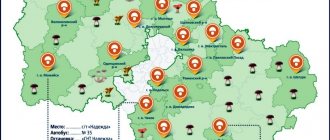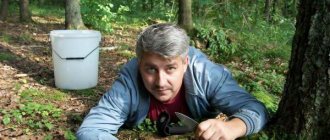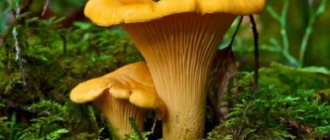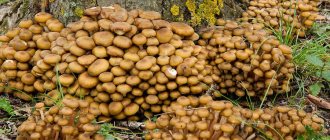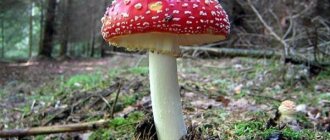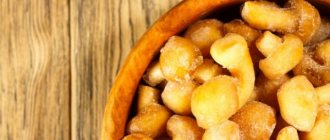Of course, the weather makes its own adjustments to when honey mushrooms start to appear in the Moscow region in 2022. But, traditionally, summer honey mushrooms can be collected at the end of summer, but the most delicious ones, autumn honey mushrooms, appear in the forests somewhere in mid-September. Again, it all depends on the weather, but, as a rule, if there are no disasters, then mushroom pickers can focus on this period.
When will honey mushrooms start to appear in the Moscow region in 2022?
Mushrooms are a gift of nature and many people strive to collect mushrooms in the summer and autumn. You should always check your plans with the mushroom calendar in order to clearly understand what, where, and when you can collect. Again, you need to be 100% sure of the harvest, so put in the basket only those mushrooms that you know for sure.
Openok translated from Latin into Russian means “bracelet”. This name is not at all surprising, because if you look at the stump on which honey mushrooms are most often comfortably located, you can see a peculiar form of mushroom growth in the form of a ring.
Honey mushrooms - how to distinguish edible and inedible
An experienced mushroom picker can easily distinguish false mushrooms from edible ones, and although certain types of false mushrooms are considered conditionally edible, it is better not to take risks, but to be guided by the rule: “If you’re not sure, don’t take it.”
False honey mushrooms
What do false mushrooms look like?
- The color of the cap of real honey mushrooms is light beige or brownish in color; the caps of inedible honey mushrooms are more brightly colored and can be rusty brown, brick red or orange.
- False sulfur-yellow honey mushrooms, which have a color similar to the real ones, are considered especially dangerous.
- To distinguish honey mushrooms from false honey mushrooms, you also need to know that the surface of the cap of edible honey mushrooms is covered with special specks - scales, darker than the cap itself. False honey mushrooms have a smooth cap, in most cases wet, and after rain it becomes sticky. As the mushroom grows, the scales disappear; lovers of overgrown mushrooms should take this into account.
- The difference between false mushrooms also lies in the plates of the mushroom. The reverse side of the cap of real edible honey mushrooms consists of many white, cream or white-yellow plates. The plates of poisonous honey mushrooms are green, bright yellow or olive-black. False brick-red honey fungus often has a cobweb formation under its cap.
The main differences between false mushrooms and edible ones
- Edible honey mushrooms have a characteristic mushroom aroma; false ones usually smell strongly of mold or smell unpleasantly of earth, and also have a bitter taste.
- To protect yourself from painful torment and serious poisoning, a novice mushroom picker should still focus on the main difference - the presence of a “skirt” under the cap of a real honey mushroom.
Autumn honey mushrooms
Autumn honey fungus is the most common of all honey mushrooms. Also known as “autumn tree” and “true honey fungus”.
The cap of such a mushroom reaches from 4 to 15 cm in diameter, at first it is convex, later flat, and may also have a tubercle in the middle, specks and small brownish scales. The color of the cap is gray-brown, beige or light brown. It is usually darker towards the middle. The flesh of the cap is dense and white and emits a pleasant mushroom smell. At first, the plates are covered with a white film, and then, as they grow, they acquire a light brown tint and dark spots. In addition, over time, the film comes off the cap, hanging on the stem like a ring.
Autumn honey mushrooms
The leg is thin and fibrous. The length of the leg is 5-12 cm, and its diameter is 0.5-2 cm. The color of the leg varies from top to bottom, starting from light brown and ending with dark brown.
Autumn spore powder is white, which, by the way, is its main difference from false mushrooms.
Autumn honey mushrooms can be found in the forest zone (literally everywhere) and gardens. They primarily grow on the stumps of coniferous and deciduous trees. Also, their frequent place of residence is windbreaks, soil and tree roots. During drought, autumn leaves can be found on drying trees (at a height of 2-3 meters from the ground). The mass collection of these mushrooms begins at the end of August and continues until the long autumn frosts.
Autumn honey mushrooms can be confused with fleecy scale, the distinguishing feature of which is increased scaliness and a pungent odor similar to the smell of radish. The flake mushroom is also edible after preliminary boiling for at least 20 minutes, although it is not as tasty as honey mushrooms.
In terms of the degree of edibility, autumn honey mushrooms received the 3rd category, although when fried and in soups they are absolutely not inferior to either saffron milk caps, porcini mushrooms, or other cap mushrooms that occupied the 1st and 2nd categories.
When to wait again
This year in Moscow and the region the weather was good for mushrooms. Already in July, many people were picking porcini mushrooms and boletus mushrooms. From the end of August, when there were good rains, summer honey mushrooms began to grow actively.
But the season of these mushrooms is extremely short, and if you didn’t have time to enjoy the summer honey mushrooms, then there is still a season of autumn honey mushrooms ahead.
Russula and pigweed are the first to appear among the autumn mushrooms in the forests at the beginning of September. The peculiarity of these mushrooms is that they grow in families and, if you find a good clearing in the forest, you can immediately collect a bucket of mushrooms. As for pre-treatment before eating or storing for the winter, it is enough to simply boil the russula, but the pork will need to be soaked in cold water for several days.
But even after the appearance of these gifts of the forest, the time has not yet come when honey mushrooms will begin to appear in the Moscow region in 2022. After pig mushrooms and russula, porcini mushrooms, boletus mushrooms, and boletus mushrooms are actively appearing. They grow one at a time, as a rule, and it takes a long time to find them. But the taste, of course, is excellent; these mushrooms are considered “noble” among mushroom pickers.
And only then, somewhere in mid-September, autumn honey mushrooms appear in the forests. The most delicious are the young little mushrooms, but with age they do not lose their taste, they only change their appearance slightly.
Autumn honey mushrooms are very different in appearance from summer ones. For example, summer ones have a denser stem and a darker cap. And from the name it is clear that they grow in the summer. As for autumn mushrooms, they can be collected until the end of the mushroom season in the Moscow region, this is during September and October. We recommend reading how to cook mushrooms before eating.
You need to know not only the approximate dates when honey mushrooms will start in the Moscow region in 2022, but also the directions where to go on a quiet hunt from the capital. Mushroom pickers recommend considering the Leningrad highway in the area of the village of Tarakanovo, Dmitrovskoye highway, as well as Yegoryevskoye and Ryazanskoye highways, forests near the village of Zakharovo.
Mushroom picker's autumn calendar:
- September is considered the most mushroom month, because autumn mushrooms are added to summer mushrooms. In large quantities you can collect honey mushrooms, tremors, white mushrooms, and pigs.
- In October, honey mushrooms and milk mushrooms continue to be collected. As soon as night frosts begin, mushroom picking stops.
- Related Posts
- How to preserve carrots for the winter at home
- When to plant tulips in autumn in open ground in 2022
- Types, varieties and varieties of pumpkin
« Previous entry
When will honey mushrooms appear in the Moscow region in 2022?
The honey mushroom season begins in Moscow and the region in late summer and early autumn. At this time, they grow more than ever. Their place of growth is in forests along which railroad tracks are laid. Favorite places for them to appear:
- rotten stumps;
- tree trunks that have broken or are dying.
Honey mushrooms should be collected in the Moscow region taking into account their species, which grows at different times:
| Honey mushroom type | Appearance period |
| Spring | 1st decade of June |
| Summer | Aug. Sept |
| Autumn | October November |
| Winter | October-January |
In some cases, these mushrooms grow in clearings in place of trees, from the roots of which mycelium extends. This element of living nature does not migrate - it grows constantly in the same place every year if the conditions are favorable for this. For this reason, you need to remember the places where you can collect a large mushroom harvest in order to repeat the ritual a year later.
Attention! When honey mushrooms reach maturity, they age and collapse in just 24 hours. During rain, this process is delayed, so you need to go for mushrooms after the precipitation. It's better if the day is foggy.
Spring mushroom is a conditionally edible mushroom, oak-loving collibia (forest-loving). Its taste is low. Mushroom pickers do not like this species not only because of the lack of taste - the flesh of its representatives is thin. It appears in forests in May and can produce crops until late autumn. It is found in large numbers along the path of mushroom “hunters” in June-July. In the Moscow region such honey mushrooms are rare “guests”.
Summer, incl. meadow, begins to bear fruit in the first month of summer. In the Moscow region, such mushrooms are collected from August to September, sometimes the collection period lasts until October.
Mushroom pickers prefer autumn varieties. Honey mushrooms in the Moscow region can be collected in September; they are fragrant and fleshy. This is not surprising, because... The weather conditions are favorable for this: from the end of August until October there are heavy rains, but the temperature still remains above 10℃ with a plus sign. In addition, their growth is fast: a week is enough for them, and not 1.5, like other mushrooms. In addition, they recover after cutting in 12 hours to 3 days.
You can go for the mushroom harvest a few days after the end of the rainy season. Thanks to the fog, the earth is saturated with moisture, so after them the honey mushrooms are fleshy. The ideal time to go to the forest is early in the morning.
The winter species grows at temperatures 7℃ above zero. They are not afraid of the first frosts - they are simply covered with an ice crust. And when it thaws, the mushrooms continue to grow.
General table of dates for the appearance of mushrooms in the Moscow region
Most often, intensive reproduction of spore organisms is stimulated by high humidity. It is after the rains that a large number of mushrooms of various types appear. But there are species of a separate kingdom that prefer air and soil dryness. The period of reproduction of such fungi occurs during dry periods.
However, the duration of fruiting is influenced by current weather conditions, since drought or high humidity must correspond to a specific temperature. The approximate dates for the types of mushrooms are given in the table, reproduction is indicated by “—” - weak, and “+” - massive.
| View | May | June | July | August | September | October | November | December |
| White | + | — | + | — | + | + | + | — |
| Boletus | — | + | + | + | + | + | — | — |
| boletus | — | + | + | + | + | + | — | — |
| Butter | — | — | — | — | + | + | + | — |
| Morel mushrooms | — | + | — | — | — | — | — | — |
| Chanterelles | — | — | + | — | + | — | — | — |
| Champignon | — | — | + | + | + | — | — | — |
| Honey mushrooms | — | — | + | + | + | + | — | — |
Having decided on the timing, it is worth starting to develop the route. Preparatory work will help you avoid disappointment and returning home with an empty basket.
Where to collect honey mushrooms in the Moscow region
In the Moscow region, the mushroom season will begin in 2022 at the end of August and beginning of September. At this time, the weather is pleasant with precipitation in the form of rain, air humidity reaches 80%, there are no frosts, and on sunny days the air temperature reaches 20℃ with a plus sign. These are ideal conditions for the development of mushrooms of any variety, not just honey mushrooms.
Main directions
In the Moscow region you can find several varieties of honey mushrooms: spring, summer, autumn and winter. Each of them has its own time for ripening, and the amount of harvest depends on weather conditions. Mostly mushroom pickers find “prey” after warm showers in mixed forests, birch and pine groves. The main directions in which honey mushrooms can be collected are:
- Leningradskoe - “Firsanovka”, “Podrezkovo”, “Povarovo”, “Golovkovo”, “Pokrovka”, “Frolovskoe”;
- Belarusian - “Zhavoronki”, “Petelino”, “Malye Vyazemy”, “Golitsyno”, “Khlyupino”, “Skorotovo”, “Kubinka”;
- Kyiv - “Victory”, “Dachnaya”, “Bekasovo”, “Selyatino”, “Nara”, “Zosimova Pustyn”;
- Yaroslavskoe - “Sofrino”, “Pushkino”, “Ashukinskaya”, “Kalistovo”, “Abramtsevo”;
- Kazanskoye - “Chernaya”, “Gzhel”, “Bronnitsy”, “Antsiferovo”, “Podosinki”, “Faustovo”, “Sands”, “Vinogradovo”, “Lukhovitsy”, “Egoryevsk”;
- Paveletskoe.
Attention! The Yaroslavl direction, namely the massif near Pushkino, is recognized as the most environmentally friendly in the Moscow region. Due to the fact that mushrooms accumulate harmful substances from the environment, this is an ideal place for harvesting mushrooms, because there are almost no toxins here.
Most of all, honey mushrooms grow along Kazansky, in the forests near the Gzhel, Shevlyagino and Kuzyaevo stations.
Where there are always a lot of honey mushrooms in Moscow and the Moscow region
According to experienced mushroom pickers, it is better to collect honey mushrooms in the Kiev direction. This rule especially applies to autumn species. The Leningrad direction, passing through the Firsanovka, Nazaryevo, Elino, and Poyarkovo stations, is also considered a good place to fill a full basket of mushrooms.
Finding autumn honey mushrooms in the forests near Moscow will not be difficult, since the climatic conditions of the region contribute to the active growth of representatives of a separate kingdom of wildlife. And in the forests located around the capital, you can reap a large harvest.
The most popular among mushroom pickers are the forests located near the settlements of Golygino, Novovoronino, Vysokovo and Morozovo. But it is important to remember that there are a lot of people here during the season.
In the region, places with a large number of mushrooms are considered:
- forests around the Gremyachiy waterfall. They are warm and moist, and this environment is ideal for the growth of fruiting bodies;
- forest areas near the 43 km platform. Here you can walk along the paths, moving along the Vyaz River. The route is long, but the harvest will be plentiful;
- in the forests near the Skhodnya river near the station. "Podrezkovo". Here, in addition to honey mushrooms, you can find saffron milk caps, boletus mushrooms and boletus mushrooms.
Experienced mushroom pickers also advise visiting mixed forests located near the village of Elino, near the station. "Firsanovka".
And if you don’t want to go far from the capital, then you can organize a “hunt” near Novovoronino, Golygino, Shapilovo and Morozovo.
The most popular destinations for collecting honey mushrooms near Moscow
If it is not possible to travel long distances, it is worth exploring where in the nearest forests you can collect honey mushrooms. Of course, you will still have to move at least a couple of tens of kilometers away from the city. Firstly, due to the fact that there are not many forest areas near the metropolis, and secondly, in the nearest areas the ecology is not the best, and honey mushrooms accumulate harmful substances. The following places are worth trying:
- In the Ryazan direction, excellent forests are located near the Biserovo station. There are large forests there and if you find a good place, you can collect a huge amount of mushrooms in a short time.
- Another good direction is Kazan. There, just 20 km away, you can collect honey mushrooms in the Mitino area, a little further is Knyazevo, there are also enough good forests there.
- If you drive to the Pushkino railway station and get to the village of Stepankovo nearby, you can collect a lot of honey mushrooms. Another point worth remembering is Ashukinskaya station.
- Pravda station is an excellent place with humid forests, in which there are many stumps and old wood, which creates ideal conditions for the growth of mycelium.
When searching in forests, you should choose directions where there are a lot of old trees and light does not penetrate very well. The more moisture, the better the conditions for honey mushrooms; they do not like sunny areas.
Growing conditions
Honey mushrooms grow in families on fallen trees or dilapidated stumps. To harvest a good harvest, it is also important to determine the weather conditions that are necessary for the growth of mushrooms. One of the main aspects is temperature. It should be in the range of 15-26℃ heat. If this figure is exceeded, the growth of representatives of this kingdom of living nature will slow down, and during drought they will dry out and rot.
In addition, air humidity is also important for honey mushroom growth. Together with the required temperature, it creates ideal conditions for a rich harvest of mushrooms: they will bear fruit after every rain.
But there must also be good air circulation in the layers of soil through which the honey mushroom mycelium passes.
In case of severe drying out of the earth, its flooding and freezing, the growth and development of roots stops, but their viability is preserved.
The lifespan of honey mushrooms is 11 days. Extreme heat or cold is detrimental to the growth of mushrooms. In addition, they become weak due to the presence of worms and insects.
Poisonous honey mushrooms
Be careful when collecting honey mushrooms - in the forests near Moscow you can also find a poisonous, inedible variety. Most often it is a sulfur-yellow poisonous honey fungus.
How to recognize it:
- No “skirt” and completely smooth skin without scales.
- Bright yellow smooth cap.
- Yellow, green or olive-black plates.
- Mushrooms smell like mold or damp earth.
Important! This species leads to poisoning, which can be fatal - it should absolutely not be eaten!
Another conditionally poisonous false honey fungus is brick-red. Opinions differ regarding this mushroom; some consider it poisonous, while other mushroom pickers consider it edible. But is it worth the risk?
Honey mushrooms. (Photo used under standard license ©ogorodnye-shpargalki.ru)
How to distinguish edible mushrooms from false ones
Honey mushrooms are one of the popular varieties of mushrooms. This is not surprising, since often a lot of them grow within one area. There are many subspecies in one family, including edible and poisonous specimens. They have many similar characteristics, so it is not difficult to confuse them. But there are still specific criteria to distinguish them. Edible honey mushrooms in the Moscow region can be collected if you pay attention to:
- Fruiting body. Real mushrooms have a pronounced membranous rim.
- Edible ones smell like mushrooms, while poisonous specimens have an unpleasant odor.
- The caps of real mushrooms are colored in light brown shades, while the inedible mushrooms have bright colors.
- The caps of young edible honey mushrooms have a scaly structure, while those of poisonous mushrooms have a smooth structure.
Attention! Honey mushrooms come in spring, summer, autumn and winter. But only the last variety does not have poisonous counterparts.
In addition to all of the above, there are plates under the cap of all types. Only in edible species they are colored in cream shades, while in poisonous ones they are yellowish, greenish and even black. To understand what false mushrooms look like, you can look at the photo.
It’s not enough to know when mushrooms will grow in the Moscow region in 2022. It is important to study the growth map of honey mushrooms in advance and learn to identify edible varieties from poisonous ones.
How to pick good mushrooms
A good mushroom can be identified by:
- by smell: it resembles the smell of wood. Bad mushroom has the smell of rotten wood.
- by color: yellow, yellow-brown, yellow-green, calm color, with white flesh.
- by scales: good ones have them both on their caps and on their legs.
- to taste: if you feel bitterness, spit it out. Such mushrooms are bad - they need to be thrown away.
- according to the plates: they should be light-colored, coffee-milk. Bad mushrooms are yellow, olive, dirty.
Description
Honey mushrooms are one of the most popular mushrooms because... Usually there are a lot of them growing within a limited area. The family includes many species, among which there are both edible and insidious poisonous representatives. Due to their very similar characteristics, there is a possibility of confusion between them, but they still have significant criteria. What to look for when collecting edible honey mushrooms in the Moscow region:
- The fruiting body of true mushrooms has a pronounced membranous rim - inedible mushrooms do not have it.
- Edibles have a characteristic mushroom aroma, the smell of poisonous specimens is repulsive.
- The caps of true honey mushrooms are painted in calm light brown colors - inedible ones are characterized by a striking color.
- The caps of young edible specimens are scaly, while those of poisonous specimens are smooth.
In addition, under the cap of all types there are plates. In edible ones they are creamy, while in poisonous ones they have yellowish, greenish and even black shades. You can see what false mushrooms look like in the photo below.
Honey mushrooms are parasitic mushrooms for trees such as oak, birch, acacia and hazel. If a tree with a whitish coating catches your eye in the forest, then in a year it will be covered with a family of mushrooms. Under the bark of rotten stumps there is often hidden a mycelium of honey mushrooms, which will give rise to a large family after the rains.
Interesting!
There are winter, spring, summer and autumn honey mushrooms. If the temperature suitable for the development of summer mushrooms is + 21-23 C, then for spring and autumn mushrooms + 11-13 C. Winter mushrooms flicker in the snow before the onset of severe frosts.
Winter mushrooms do not have poisonous counterparts. In addition, they are clearly visible among the first snow. Therefore, you can safely harvest the yellow-orange harvest without fear for your health.
Best weather for mushroom picking
If you plan to store the mushroom harvest fresh, it is better to go on a “quiet hunt” on a fine day. If collected in rainy weather, they quickly deteriorate. If the goal is to make fragrant preparations, you can go to the forest on any day, be it cloudy or sunny.
The main thing is that it is early in the morning. With heavy dew, the shiny cap is more noticeable among the leaves. In addition, the search is helped by the absence of oblique sunlight, which, when they appear, blinds. Due to the play of the sun, glare is misleading.
The most mushroom places in the Moscow region
Every year we have to look for where in the Moscow region we can collect porcini mushrooms and others in large quantities. Mushroom spots are constantly changing—you shouldn’t expect them to appear in the same area year after year. However, the most promising areas can be identified. One of these is Savelovskoye (st. Iksha, Tourist and Morozki). People come here for valuable chanterelles and fragrant oyster mushrooms that grow on tree trunks.
Since mushroom pickers set out for their “prey” as early as possible, they prefer traveling by train. It is worth paying attention to the following areas:
- Yaroslavskoe. Coming out to the station Semkhoz, Abramtsevo and Kalistovo can count on finding porcini mushrooms, oyster mushrooms, champignons and boletus.
- Kyiv. In the vicinity of Naro-Fominsk, many porcini mushrooms are also found.
- Near the station In Kuzyaevo they collect porcini mushrooms, row mushrooms, and honey mushrooms. Boletus mushrooms are often encountered.
On a note!
This year, the search for mushrooms in the vicinity of the station remains relevant. Frolovskoe, Podrezkovo, Pokrovka and Golovkovo.
